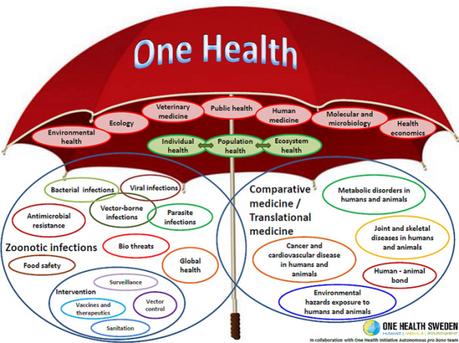
From the CDC Webpage on the twelve Manhattan Principles:
These “Manhattan Principles” urge world leaders, civil society, the global health community, and institutions of science to holistically approach the prevention of epidemic/epizootic disease and the maintenance of ecosystem integrity by:
- Recognizing the link between human, domestic animal, and wildlife health, and the threat disease poses to people, their food supplies and economies, and the biodiversity essential to maintaining the healthy environments and functioning ecosystems we all require.
- Recognizing that decisions regarding land and water use have real implications for health. Alterations in the resilience of ecosystems and shifts in patterns of disease emergence and spread manifest themselves when we fail to recognize this relationship.
- Including wildlife health science as an essential component of global disease prevention, surveillance, monitoring, control, and mitigation.
- Recognizing that human health programs can greatly contribute to conservation efforts.
- Devising adaptive, holistic, and forward-looking approaches to the prevention, surveillance, monitoring, control, and mitigation of emerging and resurging diseases that fully account for the complex interconnections among species.
- Seeking opportunities to fully integrate biodiversity conservation perspectives and human needs (including those related to domestic animal health) when developing solutions to infectious disease threats.
- Reducing demand for and better regulating the international live wildlife and bushmeat trade, not only to protect wildlife populations but to lessen the risks of disease movement, crossspecies transmission, and the development of novel pathogen-host relationships. The costs of this worldwide trade in terms of impacts on public health, agriculture, and conservation are enormous, and the global community must address this trade as the real threat it is to global socioeconomic security.
- Restricting the mass culling of free-ranging wildlife species for disease control to situations where there is a multidisciplinary, international scientific consensus that a wildlife population poses an urgent, significant threat to human health, food security, or wildlife health more broadly.
- Increasing investment in the global human and animal health infrastructure commensurate with the serious nature of emerging and resurging disease threats to people, domestic animals and wildlife. Enhanced capacity for global human and animal health surveillance and for clear, timely information-sharing (that takes language barriers into account) can only help improve coordination of responses among governmental and nongovernmental agencies, public and animal health institutions, vaccine / pharmaceutical manufacturers, and other stakeholders.
- Forming collaborative relationships among governments, local people, and the private and public (i.e. non-profit) sectors to meet the challenges of global health and biodiversity conservation.
- Providing adequate resources and support for global wildlife health surveillance networks that exchange disease information with the public health and agricultural animal health communities as part of early warning systems for the emergence and resurgence of disease threats.
- Investing in educating and raising awareness among the world’s people and in influencing the policy process to increase recognition that we must better understand the relationships between health and ecosystem integrity to succeed in improving prospects for a healthier planet.
